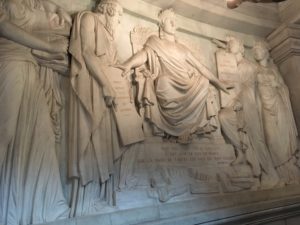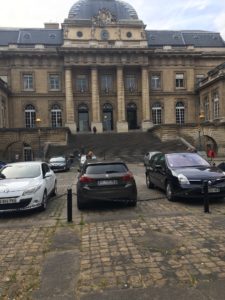Paris: histoire, droit, et lois
For the legal historian, walking around central Paris is always of interest. For example, close to where your blogger had his flat in the Marais, is an elegant house on which there is a plaque stating that Raymond (or Roumain) de Sèze (1748-1828), one of the lawyers of Louis XVI at his trial, had lived in 1793. He was noted for his spirited defence of the unfortunate king. He had earlier acted for Marie-Antionette in the affair of the Queen’s necklace. After the King’s trial de Sèze was imprisoned for a while, though released on the fall of Robespierre. After the Restoration, he became Président of the Cour de Cassation in 1815. His tomb is to be found in the Père Lachaise Cemetery.
The Palais de Justice in Paris is very grand complex of buildings on the Île de la Cité.
One of its interesting features is the Salle des Pas Perdus, which has a function rather similar to that of Parliament Hall in Parliament House, Edinburgh, as a giant vestibule connecting parts of the building, in which one one often sees avocats in their robes walking and discussing. Attached to this elaborate complex is the Conciergerie, the medieval royal palace that was used as a prison, for, among others, Marie-Antoinette. At the end of the Conciergerie is the grand classical, or perhaps rather baroque, pile of the Cour de Cassation. This functions as the court of appeal in civil matters.
Nearby is the Tribunal de Commerce, not attached to this grand complex.

On the tower at the end of the Conciergerie is a remarkable clock, which has given its name to the nearby quai, the Quai d’Horloge. The clock here dates from the late fourteenth century, and was the first public clock in France. It has been repaired, restored and acquired a new dial several times through the centuries; and it was beautifully restored again in 2012. What is interesting to the legal historian are the allegorical figures. These were restored in the mid-nineteenth century, after being burned during the Revolution. They are mannerist in style, and represent law and justice.
The iconography of figures of justice is always very interesting. This figure has no blindfold are even. The Latin inscription on the top alludes to Henry III of France; that on the bottom is more interesting here: it states that “This machine that divides the hours into twice six warns us to protect justice and uphold the laws.” It is tempting to reflect on the deeper meanings that this suggests in the context of a clock. But it is interesting to reflect on them in the context of de Sèze’s defence of Louis XVI, before the Convention, which de Sèze described as full of accusers but not of judges, and in which he remarked that Louis seemed to be the only Frenchman without rights.
Codification, of course, emphasised that in France droit is expressed in lois. One can think of the projects of Henri François d”Aguesseau (1668-1751), Chancellor, commemorated with a statue outside the Assemblée Nationale, and eventually of the various projets of
Cambacérès during the 1790s, as attempts were made to unify and reform French law.
This, of course, eventually brings us to Napoleon Bonaparte. He is too famous to need much discussion. (It is worth noting here that the University of Edinburgh owns a table he used in imprisonment in St. Helena.) The significance of the Code civil des Français (later Code Napoléon) as one of the most important legal texts hardly needs stating. Napoleon’s remains were eventually returned to France from St Helena and buried in a huge new crypt in the Eglise du Dôme, the splendid baroque church, added for Louis XIV to the Hôpital des Invalides in Paris. It is a matter of taste, but to your blogger the tomb and its associated walk-way and other statuary and paraphernalia, all in a heavy, almost vulgar, Greek-revival style, form an unfortunate contrast with the baroque Louis XIV church, and indeed seem artistically to be at war with it.
This said, the tomb is fascinating. The walkway round it contains huge sculptures representing significant non-military achievements of Napoleon. The sculptor obviously had in mind Greek commemorative sculptures of the Hellenistic period. One, for example, commemorates the Code de commerce. One inevitably is devoted to the Code civil. Napoleon is portrayed as Greek lawgiver, perhaps a Solon, surrounded by acolytes and allegorical figures. On his right, the viewer’s left, is a tablet referring to Roman law and Justinian’s Institutes. Napoleon grips its corner. On his left, the viewer’s right, is a tablet referring to the Code civil, on which is an inscription, to which he points with his finger, stating “justice égale et intelligible pour tous”. It is as if the ancient imperial law of Rome has traveled through and been transformed by his body into the modern Code. The stone tablets also make the legal historian think of Moses and of the Twelve Tables (even if the last were not initially carved in stone). Perhaps he is a new Moses leading his people from the bondage of the old law to a new dispensation. Below his feet is the rather hubristic inscription: “My Code alone, by its simplicity, has done more good in France than the mass of previous laws.” Other books and scrolls of law are found discarded below the Emperor’s feet. These include the works of Domat and Pothier, whether discarded as replaced, or after use in drafting the code, or both, is for the viewer to decide!






